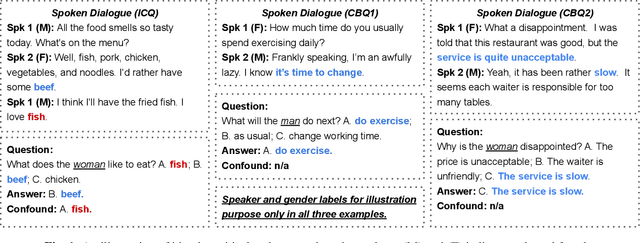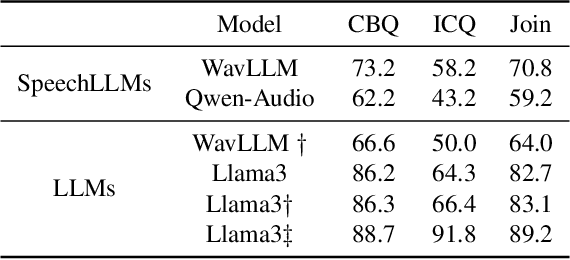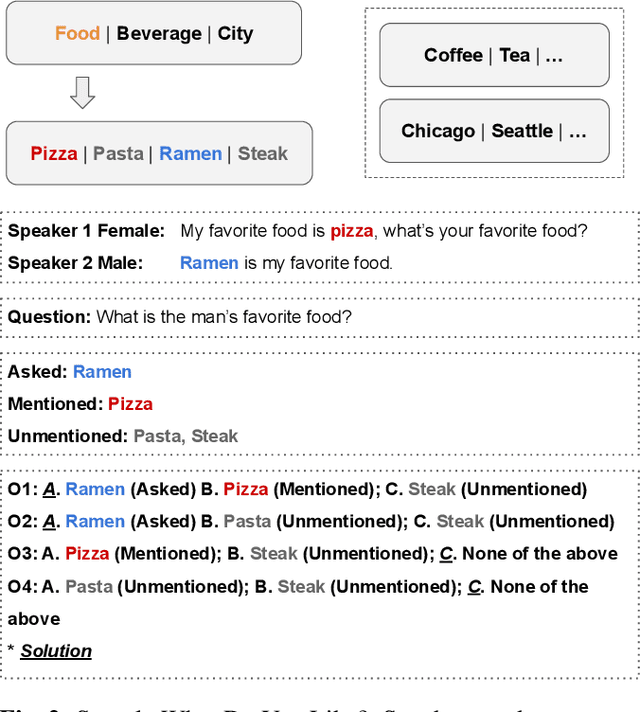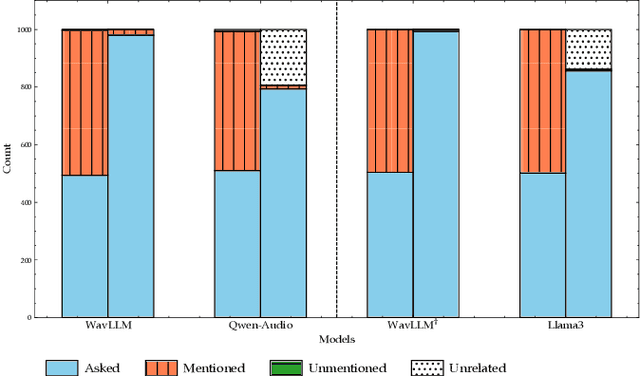Xilin Jiang
Layer-wise Minimal Pair Probing Reveals Contextual Grammatical-Conceptual Hierarchy in Speech Representations
Sep 19, 2025Abstract:Transformer-based speech language models (SLMs) have significantly improved neural speech recognition and understanding. While existing research has examined how well SLMs encode shallow acoustic and phonetic features, the extent to which SLMs encode nuanced syntactic and conceptual features remains unclear. By drawing parallels with linguistic competence assessments for large language models, this study is the first to systematically evaluate the presence of contextual syntactic and semantic features across SLMs for self-supervised learning (S3M), automatic speech recognition (ASR), speech compression (codec), and as the encoder for auditory large language models (AudioLLMs). Through minimal pair designs and diagnostic feature analysis across 71 tasks spanning diverse linguistic levels, our layer-wise and time-resolved analysis uncovers that 1) all speech encode grammatical features more robustly than conceptual ones.
SightSound-R1: Cross-Modal Reasoning Distillation from Vision to Audio Language Models
Sep 19, 2025Abstract:While large audio-language models (LALMs) have demonstrated state-of-the-art audio understanding, their reasoning capability in complex soundscapes still falls behind large vision-language models (LVLMs). Compared to the visual domain, one bottleneck is the lack of large-scale chain-of-thought audio data to teach LALM stepwise reasoning. To circumvent this data and modality gap, we present SightSound-R1, a cross-modal distillation framework that transfers advanced reasoning from a stronger LVLM teacher to a weaker LALM student on the same audio-visual question answering (AVQA) dataset. SightSound-R1 consists of three core steps: (i) test-time scaling to generate audio-focused chains of thought (CoT) from an LVLM teacher, (ii) audio-grounded validation to filter hallucinations, and (iii) a distillation pipeline with supervised fine-tuning (SFT) followed by Group Relative Policy Optimization (GRPO) for the LALM student. Results show that SightSound-R1 improves LALM reasoning performance both in the in-domain AVQA test set as well as in unseen auditory scenes and questions, outperforming both pretrained and label-only distilled baselines. Thus, we conclude that vision reasoning can be effectively transferred to audio models and scaled with abundant audio-visual data.
ArrayDPS: Unsupervised Blind Speech Separation with a Diffusion Prior
May 17, 2025Abstract:Blind Speech Separation (BSS) aims to separate multiple speech sources from audio mixtures recorded by a microphone array. The problem is challenging because it is a blind inverse problem, i.e., the microphone array geometry, the room impulse response (RIR), and the speech sources, are all unknown. We propose ArrayDPS to solve the BSS problem in an unsupervised, array-agnostic, and generative manner. The core idea builds on diffusion posterior sampling (DPS), but unlike DPS where the likelihood is tractable, ArrayDPS must approximate the likelihood by formulating a separate optimization problem. The solution to the optimization approximates room acoustics and the relative transfer functions between microphones. These approximations, along with the diffusion priors, iterate through the ArrayDPS sampling process and ultimately yield separated voice sources. We only need a simple single-speaker speech diffusion model as a prior along with the mixtures recorded at the microphones; no microphone array information is necessary. Evaluation results show that ArrayDPS outperforms all baseline unsupervised methods while being comparable to supervised methods in terms of SDR. Audio demos are provided at: https://arraydps.github.io/ArrayDPSDemo/.
Bridging Ears and Eyes: Analyzing Audio and Visual Large Language Models to Humans in Visible Sound Recognition and Reducing Their Sensory Gap via Cross-Modal Distillation
May 11, 2025Abstract:Audio large language models (LLMs) are considered experts at recognizing sound objects, yet their performance relative to LLMs in other sensory modalities, such as visual or audio-visual LLMs, and to humans using their ears, eyes, or both remains unexplored. To investigate this, we systematically evaluate audio, visual, and audio-visual LLMs, specifically Qwen2-Audio, Qwen2-VL, and Qwen2.5-Omni, against humans in recognizing sound objects of different classes from audio-only, silent video, or sounded video inputs. We uncover a performance gap between Qwen2-Audio and Qwen2-VL that parallels the sensory discrepancy between human ears and eyes. To reduce this gap, we introduce a cross-modal distillation framework, where an LLM in one modality serves as the teacher and another as the student, with knowledge transfer in sound classes predicted as more challenging to the student by a heuristic model. Distillation in both directions, from Qwen2-VL to Qwen2-Audio and vice versa, leads to notable improvements, particularly in challenging classes. This work highlights the sensory gap in LLMs from a human-aligned perspective and proposes a principled approach to enhancing modality-specific perception in multimodal LLMs.
Unsupervised Blind Speech Separation with a Diffusion Prior
May 08, 2025Abstract:Blind Speech Separation (BSS) aims to separate multiple speech sources from audio mixtures recorded by a microphone array. The problem is challenging because it is a blind inverse problem, i.e., the microphone array geometry, the room impulse response (RIR), and the speech sources, are all unknown. We propose ArrayDPS to solve the BSS problem in an unsupervised, array-agnostic, and generative manner. The core idea builds on diffusion posterior sampling (DPS), but unlike DPS where the likelihood is tractable, ArrayDPS must approximate the likelihood by formulating a separate optimization problem. The solution to the optimization approximates room acoustics and the relative transfer functions between microphones. These approximations, along with the diffusion priors, iterate through the ArrayDPS sampling process and ultimately yield separated voice sources. We only need a simple single-speaker speech diffusion model as a prior along with the mixtures recorded at the microphones; no microphone array information is necessary. Evaluation results show that ArrayDPS outperforms all baseline unsupervised methods while being comparable to supervised methods in terms of SDR. Audio demos are provided at: https://arraydps.github.io/ArrayDPSDemo/.
AAD-LLM: Neural Attention-Driven Auditory Scene Understanding
Feb 24, 2025



Abstract:Auditory foundation models, including auditory large language models (LLMs), process all sound inputs equally, independent of listener perception. However, human auditory perception is inherently selective: listeners focus on specific speakers while ignoring others in complex auditory scenes. Existing models do not incorporate this selectivity, limiting their ability to generate perception-aligned responses. To address this, we introduce Intention-Informed Auditory Scene Understanding (II-ASU) and present Auditory Attention-Driven LLM (AAD-LLM), a prototype system that integrates brain signals to infer listener attention. AAD-LLM extends an auditory LLM by incorporating intracranial electroencephalography (iEEG) recordings to decode which speaker a listener is attending to and refine responses accordingly. The model first predicts the attended speaker from neural activity, then conditions response generation on this inferred attentional state. We evaluate AAD-LLM on speaker description, speech transcription and extraction, and question answering in multitalker scenarios, with both objective and subjective ratings showing improved alignment with listener intention. By taking a first step toward intention-aware auditory AI, this work explores a new paradigm where listener perception informs machine listening, paving the way for future listener-centered auditory systems. Demo and code available: https://aad-llm.github.io.
Exploring Finetuned Audio-LLM on Heart Murmur Features
Jan 23, 2025



Abstract:Large language models (LLMs) for audio have excelled in recognizing and analyzing human speech, music, and environmental sounds. However, their potential for understanding other types of sounds, particularly biomedical sounds, remains largely underexplored despite significant scientific interest. In this study, we focus on diagnosing cardiovascular diseases using phonocardiograms, i.e., heart sounds. Most existing deep neural network (DNN) paradigms are restricted to heart murmur classification (healthy vs unhealthy) and do not predict other acoustic features of the murmur such as timing, grading, harshness, pitch, and quality, which are important in helping physicians diagnose the underlying heart conditions. We propose to finetune an audio LLM, Qwen2-Audio, on the PhysioNet CirCor DigiScope phonocardiogram (PCG) dataset and evaluate its performance in classifying 11 expert-labeled murmur features. Additionally, we aim to achieve more noise-robust and generalizable system by exploring a preprocessing segmentation algorithm using an audio representation model, SSAMBA. Our results indicate that the LLM-based model outperforms state-of-the-art methods in 8 of the 11 features and performs comparably in the remaining 3. Moreover, the LLM successfully classifies long-tail murmur features with limited training data, a task that all previous methods have failed to classify. These findings underscore the potential of audio LLMs as assistants to human cardiologists in enhancing heart disease diagnosis.
StyleTTS-ZS: Efficient High-Quality Zero-Shot Text-to-Speech Synthesis with Distilled Time-Varying Style Diffusion
Sep 16, 2024Abstract:The rapid development of large-scale text-to-speech (TTS) models has led to significant advancements in modeling diverse speaker prosody and voices. However, these models often face issues such as slow inference speeds, reliance on complex pre-trained neural codec representations, and difficulties in achieving naturalness and high similarity to reference speakers. To address these challenges, this work introduces StyleTTS-ZS, an efficient zero-shot TTS model that leverages distilled time-varying style diffusion to capture diverse speaker identities and prosodies. We propose a novel approach that represents human speech using input text and fixed-length time-varying discrete style codes to capture diverse prosodic variations, trained adversarially with multi-modal discriminators. A diffusion model is then built to sample this time-varying style code for efficient latent diffusion. Using classifier-free guidance, StyleTTS-ZS achieves high similarity to the reference speaker in the style diffusion process. Furthermore, to expedite sampling, the style diffusion model is distilled with perceptual loss using only 10k samples, maintaining speech quality and similarity while reducing inference speed by 90%. Our model surpasses previous state-of-the-art large-scale zero-shot TTS models in both naturalness and similarity, offering a 10-20 faster sampling speed, making it an attractive alternative for efficient large-scale zero-shot TTS systems. The audio demo, code and models are available at https://styletts-zs.github.io/.
Just ASR + LLM? A Study on Speech Large Language Models' Ability to Identify and Understand Speaker in Spoken Dialogue
Sep 07, 2024



Abstract:In recent years, we have observed a rapid advancement in speech language models (SpeechLLMs), catching up with humans' listening and reasoning abilities. Remarkably, SpeechLLMs have demonstrated impressive spoken dialogue question-answering (SQA) performance in benchmarks like Gaokao, the English listening test of the college entrance exam in China, which seemingly requires understanding both the spoken content and voice characteristics of speakers in a conversation. However, after carefully examining Gaokao's questions, we find the correct answers to many questions can be inferred from the conversation context alone without identifying the speaker asked in the question. Our evaluation of state-of-the-art models Qwen-Audio and WavLLM in both Gaokao and our proposed "What Do You Like?" dataset shows a significantly higher accuracy in these context-based questions than in identity-critical questions, which can only be answered correctly with correct speaker identification. Our results and analysis suggest that when solving SQA, the current SpeechLLMs exhibit limited speaker awareness from the audio and behave similarly to an LLM reasoning from the conversation transcription without sound. We propose that our definitions and automated classification of context-based and identity-critical questions could offer a more accurate evaluation framework of SpeechLLMs in SQA tasks.
Style-Talker: Finetuning Audio Language Model and Style-Based Text-to-Speech Model for Fast Spoken Dialogue Generation
Aug 13, 2024Abstract:The rapid advancement of large language models (LLMs) has significantly propelled the development of text-based chatbots, demonstrating their capability to engage in coherent and contextually relevant dialogues. However, extending these advancements to enable end-to-end speech-to-speech conversation bots remains a formidable challenge, primarily due to the extensive dataset and computational resources required. The conventional approach of cascading automatic speech recognition (ASR), LLM, and text-to-speech (TTS) models in a pipeline, while effective, suffers from unnatural prosody because it lacks direct interactions between the input audio and its transcribed text and the output audio. These systems are also limited by their inherent latency from the ASR process for real-time applications. This paper introduces Style-Talker, an innovative framework that fine-tunes an audio LLM alongside a style-based TTS model for fast spoken dialog generation. Style-Talker takes user input audio and uses transcribed chat history and speech styles to generate both the speaking style and text for the response. Subsequently, the TTS model synthesizes the speech, which is then played back to the user. While the response speech is being played, the input speech undergoes ASR processing to extract the transcription and speaking style, serving as the context for the ensuing dialogue turn. This novel pipeline accelerates the traditional cascade ASR-LLM-TTS systems while integrating rich paralinguistic information from input speech. Our experimental results show that Style-Talker significantly outperforms the conventional cascade and speech-to-speech baselines in terms of both dialogue naturalness and coherence while being more than 50% faster.
 Add to Chrome
Add to Chrome Add to Firefox
Add to Firefox Add to Edge
Add to Edge